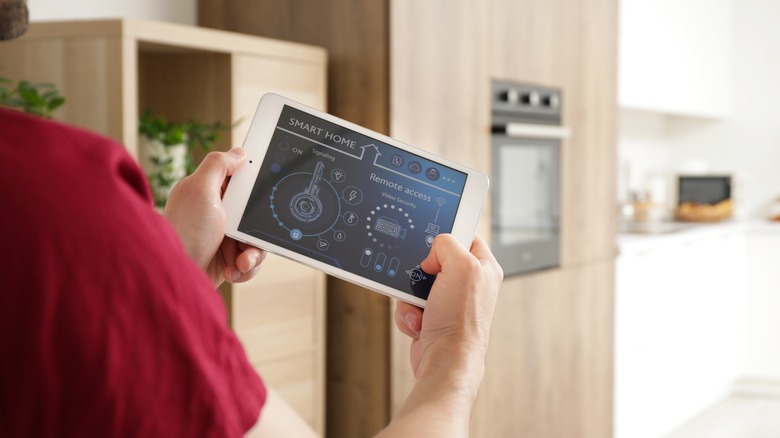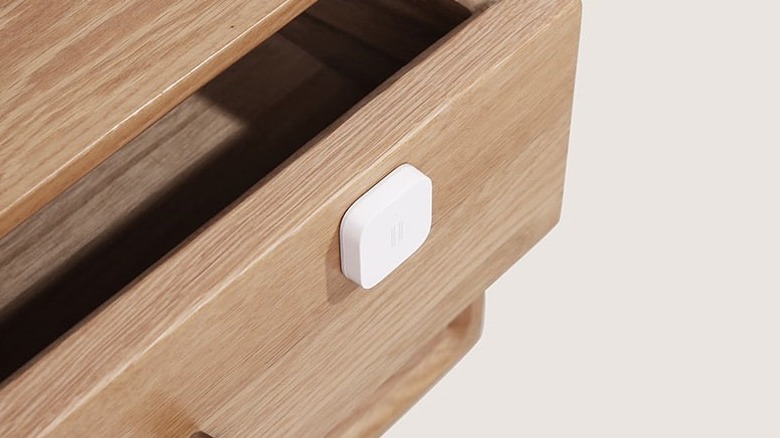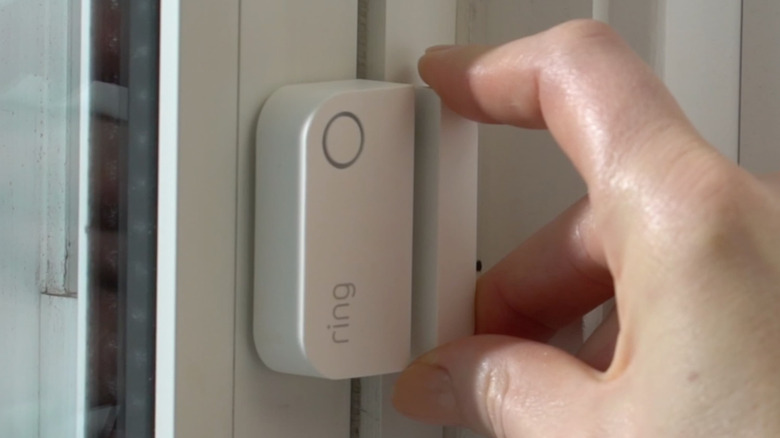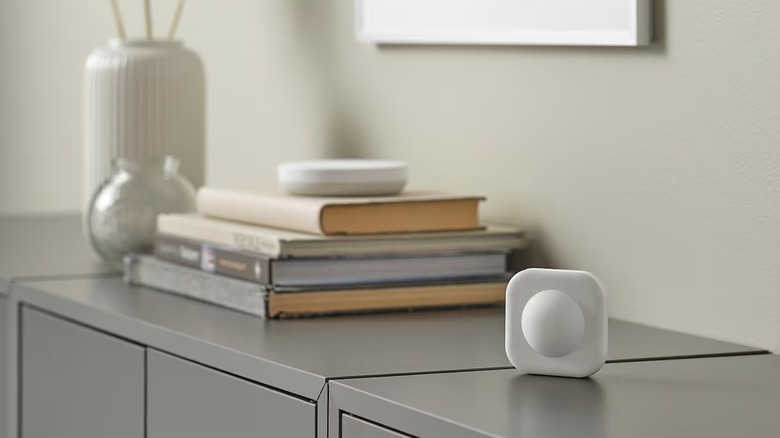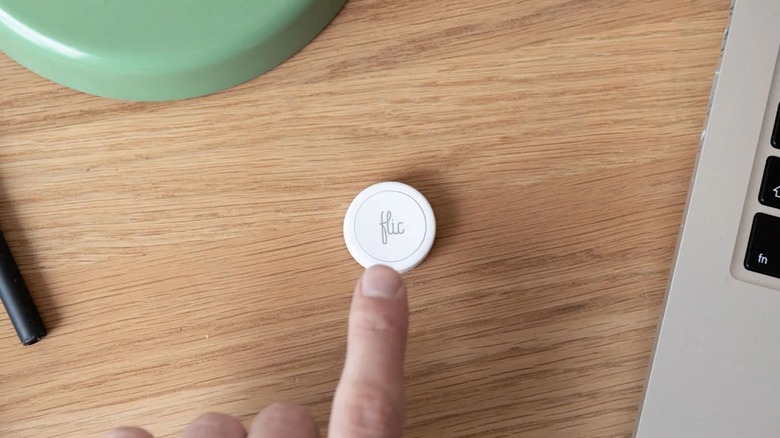5 Unexpected Uses For Your Smart Home Devices
We may receive a commission on purchases made from links.
Smart home technology has expanded beyond the common smart speaker and display. A quick browse on Amazon, and you'll find a couple different smart gadgets that make your living space even smarter. There's a motion sensor for detecting movement within a specific range, a contact sensor for checking the status of a door or window, and even a water leak detector for saving your home from unwanted leaky pipes.
Most of these smart gadgets are designed for specific applications, and chances are you got them for those advertised use cases too. But what if you bought one too many of your smart devices and don't know where else to put the rest? Thankfully, most of these little gadgets are multi-purpose, and with a little imagination, you can set them up to solve a variety of your problems at home. To give you an idea of the unexpected ways you can use smart devices, here are a few options to try.
Vibration sensor as a medicine reminder
It's easy to forget to take your medicine in the midst of a busy day. Sure, phone alarms can be somewhat reliable, but they can be a hassle to set up, especially if you have to take your pills at different hours. You can try pill organizers, but then again, distributing your meds into tiny boxes is time-consuming as well. Instead of these options, just use a vibration sensor. Vibration sensors normally come in handy for multiple uses around the house, like when you want to monitor when your dryer is done or whether someone opened a cabinet or door. However, they can double as your medicine reminder too.
For this setup, all you have to do is fix the sensor to the lid of your medicine bottle. Then, configure an automation, so the sensor sends you a notification when it doesn't detect any movement for a certain time. It's best to go with a compact battery-powered vibration sensor for this, like the Aqara Vibration Sensor.
This way, it isn't inconvenient to open your medicine bottle with it attached. You can also opt to use the sensor as is and just rely on its remote notifications. Or you can pair the sensor with other smart home devices like a smart speaker that can chime at the right time or a smart bulb that changes colors depending on the status of the bottle (opened or not).
Door sensor as a home theater mood maker
Every time you watch a movie at home, you probably go through a long checklist just to set the mood. First, you power on the TV and speakers. Then, you close the curtains, change the smart lights to the perfect color, and lower the temperature for a cozy night in. Imagine how much time you'll save if these actions are performed automatically at the same time, just by you getting the remote from the TV stand.
Although that might sound like something straight out of a sci-fi film, it's actually possible with the help of a nifty smart device: a door sensor. Typically, the top things you think of using a door sensor for is monitoring the door and window for burglars and making sure the fridge isn't left open again. But you can set it up to trigger the theater mode in your living room too.
To get started, install the sensor, which can be a TP-Link Tapo Door Sensor Mini or Philips Hue Secure Smart Contact Sensor, in a cabinet in your TV stand where you would usually store your remote control. If your TV stand doesn't have a cabinet, you can also use any container with a lid and put it on your coffee table. Just make sure the container is wide enough for your door sensor. Then, using the accompanying app, set up the sensor to activate your actions of choice. This way, whenever you open the cabinet/container, it sets off these actions right away. If your sensor permits, you can set a second trigger that reverses all the actions (e.g., turns off the lights, opens the curtains) once you return the remote to the cabinet/container after the film.
Motion sensor as cat litter box deodorizer
The last thing you want to come home to after a long day at work is the pungent smell of your cat's litter box filling the room. Sure, air purifiers placed right next to the litter box can help get rid of the odor, but you probably don't want to keep it running all day long if you're out of the house anyway. You can remotely turn it on and off instead, but then again, that means you'll have to keep monitoring the pet camera to see when your cat has gone into the litter box.
To make things easier for you, get yourself a motion sensor. This smart home device is great for switching on or off appliances and lights in a room when someone enters or leaves. However, motion sensors have clever uses at home too, one being a cat litter box deodorizer.
What you need to do is attach a small wireless motion sensor, such as the GE CYNC Wireless Smart Motion Sensor, to the inside wall or top of the litter box, somewhere it could easily detect your cat's entrance. Make sure it's secured enough so it doesn't fall when the litter box moves. Then, set up the sensor to trigger your smart air purifier (or a dumb air purifier connected to a smart plug) once your cat is inside. Keep the purifier running for about 30 minutes before shutting it down. You may need to play around with the motion sensor's sensitivity, so it can accurately tell when your pet uses the litter box.
Smart button as a home intercom
If you live with your family, then you know the struggle of having to gather everyone during mealtimes. You either need to shout, text them in the group chat, or visit their rooms one by one. Thankfully, home intercom systems are now a thing, and with just one push of a button, you can call your family members without leaving the kitchen or straining your vocal cords. You don't necessarily have to buy a brand-new home intercom setup, though — a couple of smart speakers and a smart button would do the trick just fine, too.
Smart buttons are advertised for things like turning on the lights and controlling your smart appliances. But they can also be used to deliver messages to other family members. One way to do so is with their built-in music functionality. When pressed, most smart buttons like the Flic Button and frient Smart Button can readily play your music of choice from your smart speaker. You can then assign certain songs to mean "it's time for dinner" or "let's have a movie night." If you know your way around tech and if your smart button supports it, you could have your speaker play custom MP3 recordings as well.
Another convenient feature of smart buttons is having multiple actions like press, double press, hold, and even rotate. This means you can send different messages using just a single device. For instance, a single press could alert your whole family about lunchtime, while a hold could notify a specific speaker (family member) about a chore.
Smart plug as a gadget guard
How many times have your siblings or kids snuck behind your back to play on the PS5 or watch TV? If it's more often than you'd like, you might want to install a guard for your gadgets. No, we're not talking about the typical security camera that you can talk into to scare them away. We're talking about a smart plug.
When you think of smart plugs, your first thought is probably to use them to turn off the forgotten hair curler in the bathroom or to switch on the fan when you're too lazy to get up from the bed. But there's one more thing a smart plug is useful for: power consumption monitoring. This specific feature can help you keep an eye on your devices when you're not around.
Say, your brother started playing on the PS5 (that's connected to a smart plug) without your permission. While the console is in use, it draws more power than when it's off. You can then set the smart plug to notify you when this consumption exceeds a certain threshold. If you have a smart speaker in the room, you can even have it play a spooky sound for dramatic effects (and possibly scare off your brother). Besides setting the threshold, you'll also need to configure your gadget guard to activate only during a specific schedule. This way, you can use your devices freely without setting off the speaker. For this setup to work, though, make sure your smart plug has an energy monitoring feature like the Kasa Smart Plug KP125M.
